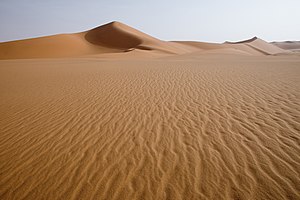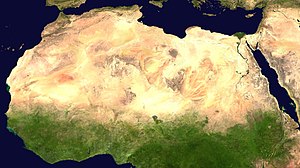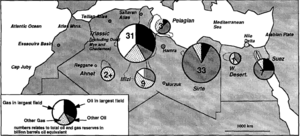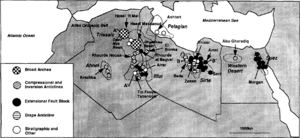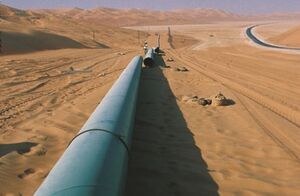Course:CONS200/2021/Oil exploration in the Sahara Desert: What are the key environmental and social threats?
Introduction to oil exploration in the Sahara Desert
The Sahara Desert is the largest desert in the world, while also rich in natural resources. An enormous wealth of natural resources including oil, natural gas, and mine, is hidden beneath the Sahara Desert[1]. Therefore, the Sahara Desert has attracted plenty of oil companies to produce oil and make huge profits. Oil exploration in the Sahara region has developed dramatically over the past ten years. This is primarily due to an increase in the oil price on the international market, where the price of crude oil went from US$10/barrel in 1998 to US$147/barrel in 2008[2]. It then fluctuated between US$70 and US$90 per barrel from 2008 till 2011[2]. The high prices that could make great profits caused an enormous change in the geography of areas of exploration around the world, and in Africa in particular. The area in the Sahara Desert where oil exploration is been conducting extends from Mauritania to Sudan and includes Algeria, Mali, Burkina Faso, Libya, Niger, and Chad[2].
The distribution of oil resources
In North Africa, the two outstanding areas are the Sirte Basin of Libya and the Triassic/lllizi Basins of Algeria. Both the Sirte and Triassic/Illizi area contain oil reserves in the range of 30-35 BBOE[3], which is the largest reserves in the world: together they contain 85% of the oil discovered in North Africa. The Sahara contains the largest oil reserves in the North African region, containing approximately 9000 BBO[3], which occupy over half the total oil resources of that area.
Note: The BOE (barrel of oil equivalent) is a unit of energy based on the approximate energy released by burning one barrel (42 US gallons or 158.9873 liters) of crude oil. MMBOE refers to million barrels of oil equivalent. BBOE refers to billion barrels of oil equivalent. BBO refers to oil in billions of barrels. All of these are metrics for oil production or consumption.
Environmental threats
Biodiversity Loss
Despite the threats to desert biodiversity from global climate change and other threats including overgrazing, agricultural and industrial expansion, the major environmental threat is oil exploration activities. Since much of the fauna in the Sahelo-Saharan region is considered to be of global conservation concern, such as the addax (Addax nasomaculatus), Dorcas gazelle (Gazella dorcas), dama gazelle (Nanger dama), Saharan cheetah (Acinonyx jubatus ssp. hecki), and Kleinmann's tortoise (Testudo kleinmanni), oil exploration would increase the risk of extinction of these species[4].
For example, the last known survival population of addax (Addax nasomaculatus) was already endangered and was listed as Critically Endangered by the IUCN Red List due to the lost of habitat and gazing sites. The addax is a kind of antelope with elongated, corkscrew horns. The animals rarely need to drink, their flat hooves help prevent them from sinking in the sand, and their coats turn from brown in winter to white in summer to help cool them down. According to SCF (Sahara Conservation Fund), there were about 200 addaxes in 2007, but the number of addaxes was fewer than 100 in 2016, and survival addaxes were scattered in eastern Niger and possibly Chad[5].
Habitat disruption
Oil exploration requires moving heavy equipment (mobile rigs for temporary drilling can weigh over 2 million pounds) into pristine environments. Clearing land for the construction of roads and platforms can further lead to wildlife habitat fragmentation[6]. Besides, in these developing countries in the region of the Sahara Desert, pipelines are often built above the ground because it is less expensive, thereby cutting off the connectivity of animals habitats[6]. Noise caused by oil exploitation and physical disturbance also affect birds, mammals, and turtle populations[6].
Poaching
Unmonitored oil exploration activities would lead tothe more fragmented distribution of biodiversity and imperil local hotspots. These activities include waste production, oil extraction, which reduces water availability, and poaching. Furthermore, it is poaching by the local military whose duty is protecting oil company camps that bring addax to be almost extinct[7]. The Nigerian government assigned a military army to protect oil workers in that area full of chaos, while some of the army men began to shoot the addax for sport and meat in violation of Nigerian law. Besides, it is was reported that about 40 Dorcas Gazelles have been slaughtered by poachers in one of Africa's largest nature reserves-Termit and Tin-Toumma National Nature Reserve in 2020[8].
Hydraulic fracturing
Due to the decrease of natural production, advanced technologies are applied to obtain oil and gas from deeper locations underground and hydraulic fracturing is one widely used method. Hydraulic fracturing literally involves the smashing of rock with millions of gallons of water along with sand and an undisclosed assortment of chemicals (and acids) in order to bring gas to the surface [9]. This method helps extract from deeper layers and has side effects like earthquakes. Another issue caused by hydraulic fracturing is soil pollution. The amount of chemically tainted soil from drilling waste increased nearly 5,100% over the past decade to more than 512,000 tons in 2011[9]. As a result, the traffic and agriculture were severely impacted and causes concerns from the public.
In addition, hydraulic fracturing also causes some side effects due to the chemicals released through its operation: benzene, toluene, xylene, and ethyl benzene (BTEX), particulate matter and dust, ground-level ozone, or smog, nitrogen oxides, carbon monoxide, formaldehyde and metals contained in diesel fuel combustion[9]. Livestock and wildlife are poisoned by the leaking toxic chemicals from the oil pipelines. Besides, oil drilling waste ponds render less available water that doesn't contain toxic chemicals for nearby wildlife.
Oil spills
In the past 20 years, there have been over 30 oil spills of 10 million gallons or more each year[10]. Oil spills may have also posed serious environmental threats to the Sahara Desert. Large oil spills sometimes occur during drilling, transport, and use, which of course affect the surrounding environment. Oil spills can devastate both nearby communities and ecosystems, eliminating wildlife and plants, and contaminate the drinking water for living organisms. Except for contaminating clean water, oil spills can also easily cause fire and explosion in the Sahara Desert where its climate is extremely hot and arid, which increases the possibility of fire and explosion. In 1998, a pipeline in the Nigerian Delta town of Warri burst and caught fires, resulting in more than 700 deaths[6]. The oil from pipeline breakage covered an area of a size of a football court, and then was suddenly ignited, explosion flame reaching 20 meters high[6].
Since oil has poisonous constituents, oil spills can harm animals and plants internally by inhalation and ingestion, and externally via skin and eye contact. Leaking oil in the ponds may also attach to the feathers and fur of birds and animals, impeding their daily activities such as flying and regulation of body temperature[11].
Other potential threats
The oil refining process creates air pollution. Converting crude oil into usable gasoline releases toxins into the atmosphere that are dangerous for ecosystem health[12].
Oil extraction emits Methane which is another kind of greenhouse gas, which is more disruptive to the environment than carbon dioxide, locking in heat more efficiently and intensifying global warming[13].
Oil transportation emits carbon as well. Nowadays, the main ways to transport oil are by water and through pipelines. Water transportation consumes a large number of fossil fuels, which emits lots of carbon. In addition, just like we mentioned above that oil spills in pipelines, it is also likely that oil leaks during water transportation. In fact, water transportation of crude oil and petroleum products leaked more than pipeline did: water transportation contributed 3000 gallons spilled per billion ton-miles in 1983 and nearly 8000 gallons per billion ton-miles in 1984, while pipeline spills contributed less than 100 gallons per billion ton-miles for both years[14].
Social-economic threats
Unemployment
Pipeline projects, according to the oil and gas industry, offer jobs and other economic advantages for communities, however, the majority of those jobs are temporary construction jobs. Between 2015 and 2017, the Dakota Access Pipeline provided 10,000 construction jobs. Only 52 persons remained working when the building was done. The Keystone XL Pipeline is expected to provide over 4,000 construction jobs but only 30 permanent ones [15].
Indigenous population
Oil extraction not only devastates the environment, but also jeopardizes the existence of indigenous peoples that live in these ecosystems. The cultural reproduction and, ultimately, the survival of indigenous groups whose way of life and well-being are inextricably linked to a desert is dependent on territorial integrity and control. Road construction is taking place across the Sahara desert, resulting in the loss of land and the relocation of aboriginal people. The building of access roads allows settlers with conflicting interests, such as logging and mining, to penetrate and occupy indigenous villages. This colonization has the potential to expose previously uninfected native populations to infectious illnesses [10].
Political threat
Who owns what when it comes to oil is one of the most important and frequently controversial issues. What resources are available and how are they distributed? The allocation of these advantages and expenses is critical to the economic and political stability of the world. The 11 OPEC countries (Algeria, Indonesia, Iran, Iraq, Kuwait, Libya, Nigeria, Qatar, Saudi Arabia, the United Arab Emirates, and Venezuela) account for around 77 percent of the world's known oil reserves, according to the Energy Information Agency. The development of supermajors has had a significant influence on the economics of several oil-producing countries. These corporations now have complete control over oil delivery and extraction. Oil-dependent developing countries experience slower economic development, greater levels of corruption, and more military spending. the dynamics of politics According to the Energy Information Agency, the 11 members of OPEC (Algeria, Indonesia, Iran, Iraq, Kuwait, Libya, Nigeria, Qatar, Saudi Arabia, the United Arab Emirates, and Venezuela) account for around a quarter of global oil production.[10]
“Traditional oil-producing countries in the Sub-Saharan Desert are mainly concentrated in North Africa and West Africa. Nigeria, Angola, Congo , Equatorial Guinea, Gabon, Sudan, and Chad are the main oil-producing countries in the sub-Saharan region. ”[15]In recent years, some countries in West and East Africa have joined the ranks of oil countries, and the southern Sahara Desert has discovered abundant natural gas resources. In West Africa, Ghana has already started exporting oil. It is also worth noting that due to political turmoil in the Sahara Desert, riots often occur, which indirectly causes fluctuations in the demand for drilling equipment. The jack-up platform is closer to the coast than the floating platform. Because it is positioned and installed, it is the easiest target for vandals. Pirates and unstable regimes will cause serious damage to long-term exploration projects. This is why there are still many exploration and drilling operations in West Africa and the construction of drilling facilities has not yet started.
Terrorist attacks
The social threat facing oil exploitation in the Sahara Desert is the unabated increase in terrorist attacks in the Sahara Desert since the beginning of this year. “Extremist organizations such as Boko Haram, Somali Youth Party, and Hadith Defenders have stepped up in West and East Africa. Activities, taking the opportunity to expand the sphere of influence, leading to frequent terrorist attacks. [16]The Nigerian military said on August 27 that it had killed at least 128 "Boko Haram" militants in several military operations in recent days, including 15 senior commanders. On August 18, the "Islamic State West Africa Province" transformed from the "Boko Haram" captured the village of Kukawa in northeastern Nigeria and hijacked hundreds of villagers. On August 16, the "Somali Al-Shabaab" occupied the Lido Hotel in the capital Mogadishu, took a large number of hostages, and engaged in fierce gun battles with government forces, killing at least 17 people and injuring more than 30 others. The turbulence of the social situation will inevitably affect the extraction of Saharan oil.
Lack of technology
On the other hand “from the perspective of technology and talent reserves, the Sahara Desert also lacks a corresponding guarantee mechanism. Its domestic oil and gas extraction technology rea relatively weak and there is a relative lack of professionals.[17]This aspect also determines that the earth worker is unwilling to hand over the exploitation rights to other countries. In addition, there are no worries about the livelihood security and energy utilization of the residents of the country, and the social welfare foundation of the whole people is relatively solid[16]. Now there is no need to rely on the sale of these resources to maintain the domestic economy and people's livelihood. We can see from the "Gates of Hell" that has been burning for nearly 50 years. On the one hand, the oil and gas resources here are really rich. On the other hand, the country is not in a hurry to extinguish fires. Instead of releasing this gas to harm the environment, it is better to let the gas be released. They burned, showing that their "confidence" is very sufficient. “Finally, if the Sahara Desert wants to extract and export the oil and gas resources in these desert areas, it is bound to lay quite long oil and gas pipelines, and the country does not yet have convenient maritime transportation channels. From the perspective of market supply and demand balance, the cost of mining and transportation is much greater than in other oil and gas enrichment areas such as the Middle East. All of the above affect the efficiency of oil extraction and transportation in the Sahara Desert.
“By the end of 2020, there are 20 oil-producing countries in the Sahara Desert, of which Nigeria, Algeria, Angola, Egypt and Libya account for about 85% of the total oil production in the Sahara Desert. ”By 2020, the oil production of Saharan countries will account for 20% of the world's total oil. “Continued high oil prices and the continuous development of new technologies have made oil and natural gas exploration in the Sahara Desert increasingly active in recent years[18].” With the new discoveries of oil and natural gas in Kenya, Uganda, Ghana, Mozambique, and Tanzania, the Sahara Desert is forming a new energy pattern. How to let the petroleum industry drive the overall economic development has become a new issue facing the countries in the Sahara Desert.
Solutions
Solutions to environmental threats
Sahara Conservation Fund
In 2004 when many species were threatened by extinction, SCF was founded, aiming to conserve the wildlife, habitats, and other natural resources in the Sahara and Sahelian Region[19]. SCF seeks assistance from stakeholders of all sectors of society to recover endangered species and make ecological processes naturally function.
SCF has a strategy with three aspects[19]:
- Saharan Species Conservation: SCF obtains expertise in the conservation and restoration of endangered species.
- Landscape Conservation: SCF contributes to sustainable landscape management for wildlife while integrating the livelihood of the local communities.
- Communication&Influence: SCF has the ability to coordinate conventions and practices and leads conservation organizations.
SCF has taken action to conserve these six species: Dama Gazelle, Scimitar-horned Oryx, Addax, Bustards, North African Ostrich, and Vultures[19].
Termit Tin Toumma National Nature and Cultural Reserve
In March 2012, with the effort of SCF and its partners, Termit Tin Toumma National Nature and Cultural Reserve was established covering an area of 100,000 square kilometers, which became the largest protected area in Africa[20]. The protected area contains one of the last remaining wild populations of the critically endangered addax and dama gazelle[20], while the survival of these last remaining populations still depends on more protection and management.
Future Perspectives on Hydraulic Fracturing
Some of the solutions can be the new fracking material instead of water. For example, the GasFrac can use the aerogel material to achieve more efficient and reliable results on fracturing than water, which causes more side effects to the environment. It seems to be a new method that exchanges the material in the cracks and make it more sustainable. Even though there are some solutions to diminish the unfriendly exploitation, in general, there's still damages caused to the environment in a long run. Some of the petroleum companies like Shell have cooperated with the local companies in Egypt to produce unconventional gas that has no negative impact on the environment. Despite the environmental impacts of hydraulic fracturing on the planet and its inhabitants, using the right technology and regulating the frequencies of these oil companies will help operators to decrease the negative effects and be more friendly to nature itself [9].
Solutions to socio-economic threats
Closing Regulatory Loopholes
The oil industry is governed by a patchwork of environmental, health, and safety laws at every stage of its life cycle.
The Sahara oil industry can imitate the U.S. oil industry, which is regulated by the Federal Land Policy and Management Act; the Federal Oil and Gas Leasing Reform Act; the Outer Continental Shelf Lands Act; the National Environmental Policy Act; the Oil Pollution Act; the Clean Air Act's National Emission Standards for Hazardous Air Pollutants, National Ambient Air Quality Standards, New Source Review (NSR), and New Source Performance Standards; the Clean Water Act's National Pollutant Discharge Elimination System and Spill Prevention Control and Countermeasure Requirements; the Emergency Planning and Community Right-to-Know Act; and the Underground Injection Control program of the Safe Drinking Water Act.[10] Closing regulatory loopholes of the oil industry can significantly decrease the unemployment rate and relieve the indigenous population's problems.
Solution to sustainable development
The social threat of the Sahara Desert must first solve another obstacle to oil and gas exploration and development is funding and infrastructure. Insufficient capital and technical support have led to insufficient initial investment in the project, and there is almost no infrastructure and equipment such as oil and gas exploration and development, transportation, and refining. Take Kenya as an example. Although a considerable amount of petroleum resources have been discovered, it will take at least four years to achieve commercial development due to the lack of necessary infrastructure.
And how the oil revenues are distributed is also an important social factor that affects the prospects of oil and gas exploration and development in the Sahara. Further avoiding resource dilemmas has become a major problem faced by new oil-producing countries. African countries that have acquired newly discovered oil and natural gas should invest more in education and infrastructure construction, while supporting the development of traditional industries to lay a solid foundation for future sustainable development. Further promote multinational companies to speed up the stationing and development. At present, US companies are accelerating their shift to Africa to find new oil reserves. According to the US government's forecast, by 2015, 25% of the country's oil imports will come from Africa. This explains the need for more oil companies to establish operations in Uganda.
Conclusion
Deserts ecologically play an as important role as forest or marine ecosystems do. For example, deserts contain 25% of terrestrial vertebrate species and are one of the top three richest biomes for terrestrial vertebrates[21]. Desert biodiversity can also yield important insights into the physiological and genetic basis of species tolerance to water stress and extreme temperatures[22], which may be critical to the adaptation and mitigation of climate change. However, oil exploitation environmentally and socio-economically threatens the Sahara Desert and the people living in it. Therefore, conservation methods are conducted, including NGO involvement, protected area, and technical advance to decrease side effects. However, more effective and efficient conservation is still in desperate need. Scientists can make an important contribution to conservation by providing relevant information and guideline. Governments can also restrict oil exploitation to prevent habitat disruption and strictly punish poaching. Furthermore, closing regulatory loopholes in the oil industry can help to reduce unemployment and alleviate the difficulties of the indigenous community. Only by doing so will the Sahara Deserts be able to support resilient ecosystems and communities that are best able to adapt to climate change.
References
- ↑ Laing, Martin (November 22, 2019). "Natural Resources of the Sahara Desert".
- ↑ 2.0 2.1 2.2 Augé, Benjamin (2011). "The New Oil-Related Issues in the Sahara". Hérodote. 142: 183–205.
- ↑ 3.0 3.1 Macgregor, Duncan (1996). "The hydrocarbon systems of North Africa". Marine and Petroleum Geology. 13: 329–340 – via Elsevier Science Direct.
- ↑ Duncan, Clare; Kretz, Daniela; Wegmann, Martin; Rabeil, Thomas; Pettorelli, Nathalie (April 14, 2014). "Oil in the Sahara: mapping anthropogenic threats to Saharan biodiversity from space". Phil.Trans. R. Soc. B. 369.
- ↑ Hall, Jani (March 2, 2016). "Poachers Went After This Amazing Antelope for Fun". National Geographic.
- ↑ 6.0 6.1 6.2 6.3 6.4 Epstein, Paul R.; Selber, Jesse (2002). Oil: A Life Cycle Analysis of Its Health and Environmental Impacts. Boston: The Center for Health and the Global Environment Harvard Medical School.
- ↑ Leahy, Stephen (August 2, 2019). "EXPANDING OIL EXPLORATION THREATENS ONE OF THE SAHARA'S LARGEST NATURE RESERVES". Pacific Standard. Retrieved November 8, 2021.
- ↑ "Dozens of endangered dorcas gazelles killed by poachers in Niger". PHYS.ORG. July 2, 2020.
- ↑ 9.0 9.1 9.2 9.3 Samir, Sarah (March 13, 2017). "THE ENVIRONMENTAL DILEMMA OF THE UNCONVENTIONALS".
- ↑ 10.0 10.1 10.2 10.3 O'Rourke, Dara (November 2003). "Just Oil? The Distribution of Environmental and Social Impacts of Oil Production and Consumption". Annual Review of Environment and Resources. 28: 587–617.
- ↑ Narsaria, Anupriya (November 13, 2021). "How Are Oil Spills Cleaned Up?". ScienceABC.
- ↑ Spooner, Alecia M. (March 26, 2016). "What Is the Environmental Impact of Petroleum and Natural Gas?". dummies.
- ↑ "What is Oil Drilling?". CONSERVE ENERGY NATURE.
- ↑ Caswell, M.F. (1993). "Balancing energy and the environment". In Gilbert, RJ. (ed.). The Environment of Oil. Boston: Kluwer Acad. pp. 179–214.
- ↑ 15.0 15.1 "Why Are Fossil Fuel Pipelines Bad for Our Climate and Communities?".
- ↑ 16.0 16.1 James, Eric (2021). "The status quo and development strategies of China's investment and development of petroleum resources in Angola. Strategic decision research".
- ↑ Su, Yi (n.d.). "Research on the Impact of Target Oilfield Development on Groundwater and Protection Measures". China University of Petroleum (East China).
- ↑ Jesse, Eisinger; Kiel, Paul. "A Massive Oil Spill Helped One Billionaire Avoid Paying Income Tax for 14 Years".
- ↑ 19.0 19.1 19.2 "About the Sahara Conservation Fund". Sahara Conservation Fund.
- ↑ 20.0 20.1 "Termit Tin Toumma, Niger". ZSL.
- ↑ Mace, G.M; Masundire, H.; Baillie, J.E.M. (2005). "Biodiversity". In Scholes, B.; Hassan, R. (eds.). Ecosystems and human-well being: current state and trends. Washington D.C.: Island Press. pp. 77–122.
- ↑ Durant, S.M.; et al. (November 28, 2013). "Fiddling in biodiversity hotspots while deserts burn? Collapse of the Sahara's megafauna". Diversity and Distributions. 20 (1): 114–122. Explicit use of et al. in:
|first=(help)
| This conservation resource was created by Course:CONS200. It is shared under a CC-BY 4.0 International License. |
